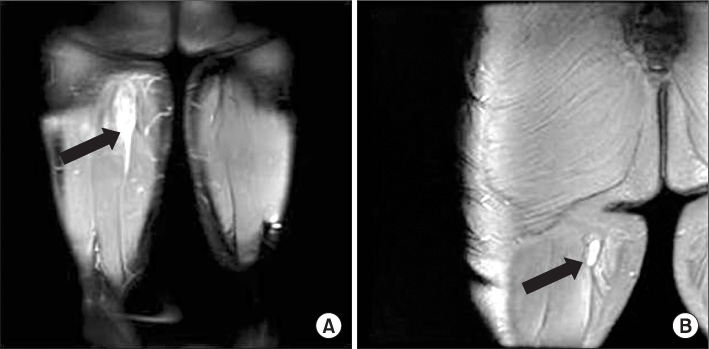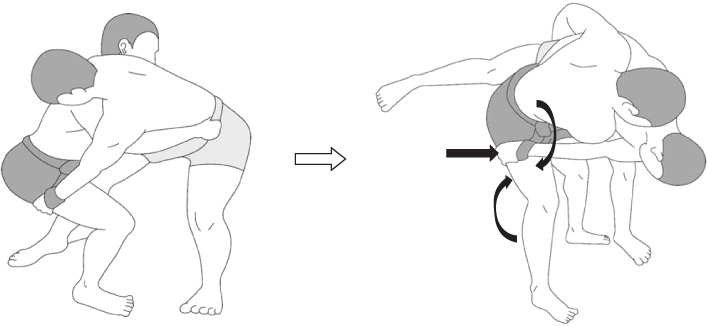J Korean Orthop Assoc.
2012 Feb;47(1):54-58. 10.4055/jkoa.2012.47.1.54.
Partial Rupture of Semitendinosus Muscle at Satba (Thigh Band) Wearing Area in a Ssireum Athlete
- Affiliations
-
- 1Department of Orthopedic Surgery, Soonchunhyang University Bucheon Hospital, Bucheon, Korea. kdmin@schmc.ac.kr
- 2Department of Orthopedic Surgery, Soonchunhyang University Seoul Hospital, Soonchunhyang University College of Medicine, Seoul, Korea.
- KMID: 1439993
- DOI: http://doi.org/10.4055/jkoa.2012.47.1.54
Abstract
- High load is concentrated on Satba wearing area of Ssireum athletes during the tournament. Muscular injuries in this area may seriously affect the athletic performance. We report a case of a 21-year-old Ssireum athlete who was experiencing pain in his left thigh (Satba wearing area) during a tournament due to the migrating mass effect of a partial ruptured semitendinosus muscle occurred approximately 6 months before. Herein is described the clinical results after surgical intervention with an added review of the relevant literature.
Keyword
Figure
Reference
-
1. Chakravarthy J, Ramisetty N, Pimpalnerkar A, Mohtadi N. Surgical repair of complete proximal hamstring tendon ruptures in water skiers and bull riders: a report of four cases and review of the literature. Br J Sports Med. 2005. 39:569–572.
Article2. Lempainen L, Sarimo J, Heikkilä J, Mattila K, Orava S. Surgical treatment of partial tears of the proximal origin of the hamstring muscles. Br J Sports Med. 2006. 40:688–691.
Article3. Brucker PU, Imhoff AB. Functional assessment after acute and chronic complete ruptures of the proximal hamstring tendons. Knee Surg Sports Traumatol Arthrosc. 2005. 13:411–418.
Article4. Ishikawa K, Kai K, Mizuta H. Avulsion of the hamstring muscles from the ischial tuberosity. A report of two cases. Clin Orthop Relat Res. 1988. (232):153–155.5. Kujala UM, Orava S, Järvinen M. Hamstring injuries. Current trends in treatment and prevention. Sports Med. 1997. 23:397–404.6. Klingele KE, Sallay PI. Surgical repair of complete proximal hamstring tendon rupture. Am J Sports Med. 2002. 30:742–747.
Article7. Schache AG, Koulouris G, Kofoed W, Morris HG, Pandy MG. Rupture of the conjoint tendon at the proximal musculotendinous junction of the biceps femoris long head: a case report. Knee Surg Sports Traumatol Arthrosc. 2008. 16:797–802.
Article8. Rhee KJ, Kim YM, Hwang DS, et al. Resection of the proximal tendinous portion in avulsion of the semimembranosus tendon from the ischial tuberosity in an adult: a case report. J Korean Orthop Assoc. 2005. 40:617–621.
Article
- Full Text Links
- Actions
-
Cited
- CITED
-
- Close
- Share
- Similar articles
-
- Isolated Semitendinosus Tendon Rupture in Non Athlete
- Muscle Infarction and Calcification of the Semitendinosus Tendon: A Case Report
- Rupture of The Adductor Longus Muscle of The Thigh: 5 Cases Report
- Chronic Tibialis Anterior Tendon Rupture Treated with Semitendinosus Autograft: A Report of Two Cases
- Reconstruction of Posterior Cruciate Ligament Using Semitendinosus Tendon (3 cases)




